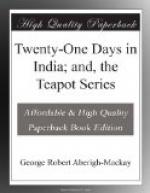’The death of Mr Aberigh-Mackay was for Central India, an almost irreparable loss. The patience, tact, and enthusiasm which he brought to his responsible educational duties were worthy of all admiration and those young Chiefs who had the benefit of his guidance will compare most favourably both in acquirements and manners with any students trained under the most favourable conditions in the colleges of British India. It so happened that at the time Mr Mackay was in charge of the Rajkumar College, a large number of important Chiefs were minors, including the Rajah of Rutlam, the junior Chief of Dewar, the Nawab of Jaora, and the two sons of His Highness the Maharaja Holkar. At present there are no Chiefs of the first rank in the Residency College. It will be well if the earnestness and devotion which animated the work of Mr. Abengh Mackay will be felt by those who succeed him.
In Elucidation No. 1—“The Viceroy”—Lord Lytton’s personal nomination of Abengh-Mackay to a Fellowship in the Calcutta University has been referred to. This act of noblesse oblige, in the highest sense of the term, was happily known to Abengh-Mackay during his lifetime.
“SOME OCCULT PHENOMENA”
In the autumn of 1880 many strange stories were afloat in India concerning the studies and practices of what is now widely known as occult science, indulged in and made manifest by the late Madame Blavatsky, the authoress of Isis Unveiled, who claimed to possess in a high degree, by nature, those attributes which spiritualists describe (without professing to understand) as “mediumship”.
Prominent members of Anglo-Indian society associated themselves with Madame Blavatsky, supported her, and believed in the bona fides of her powers, derived as Madame declared from Eastern “adepts” in the science of Yog-Vidya, as this occult knowledge is called by its devotees.
A science according to some—to others a mere vulgar imposition—with which, as maintained by certain renowned Western exponents, Lord Lytton was well versed and largely imbued, his imagina-tive account of the achievements accomplished by Vril in the Coming Race, being, according to the school and scholars of Madame Blavatsky, altogether inspired from that Eastern fount.
“Mr. Cypher Redalf, the eminent journalist,” in the proper person of Mr. A.P. Sinnett, editor of The Pioneer, a daily newspaper published at Allahabad, and then, as now to an increased degree, the leading English newspaper in India, printed in that journal an authoritative statement of various occurrences in Blavatskyian circles at Simla when Madame was on a visit to Mr and Mrs. Sinnett.
It is this statement, the outcome of “the true spirit of devout inquiry ... by persons of consideration in evening dress” which forms the leit motif of Aberigh-Mackay’s powerful satire, in which a gingham umbrella, “conceived in the liberal spirit of a bye-gone age,” is substituted for an old fashioned breast brooch set round with pearls, with glass at the front and the back, made to contain hair, which, long lost, was stated to have been recovered for its owner as a result of Madame Blavatsky’s occult powers.




